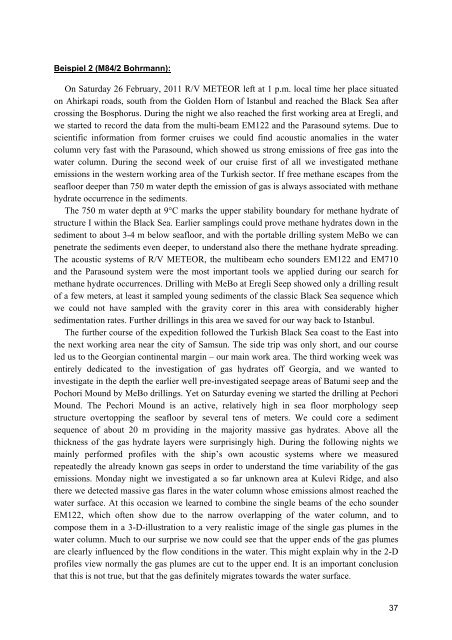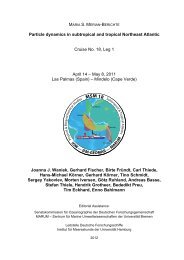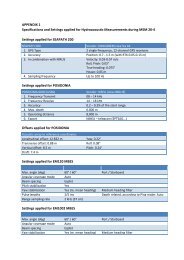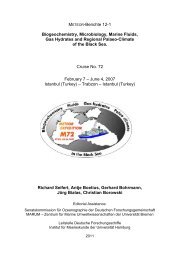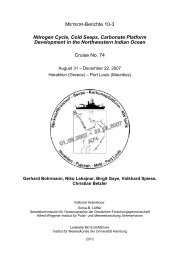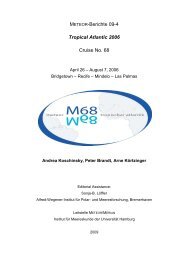LEITFADEN zur Vorbereitung und Durchführung von Expeditionen ...
LEITFADEN zur Vorbereitung und Durchführung von Expeditionen ...
LEITFADEN zur Vorbereitung und Durchführung von Expeditionen ...
Erfolgreiche ePaper selbst erstellen
Machen Sie aus Ihren PDF Publikationen ein blätterbares Flipbook mit unserer einzigartigen Google optimierten e-Paper Software.
Beispiel 2 (M84/2 Bohrmann):<br />
On Saturday 26 February, 2011 R/V METEOR left at 1 p.m. local time her place situated<br />
on Ahirkapi roads, south from the Golden Horn of Istanbul and reached the Black Sea after<br />
crossing the Bosphorus. During the night we also reached the first working area at Eregli, and<br />
we started to record the data from the multi-beam EM122 and the Paraso<strong>und</strong> sytems. Due to<br />
scientific information from former cruises we could find acoustic anomalies in the water<br />
column very fast with the Paraso<strong>und</strong>, which showed us strong emissions of free gas into the<br />
water column. During the second week of our cruise first of all we investigated methane<br />
emissions in the western working area of the Turkish sector. If free methane escapes from the<br />
seafloor deeper than 750 m water depth the emission of gas is always associated with methane<br />
hydrate occurrence in the sediments.<br />
The 750 m water depth at 9°C marks the upper stability bo<strong>und</strong>ary for methane hydrate of<br />
structure I within the Black Sea. Earlier samplings could prove methane hydrates down in the<br />
sediment to about 3-4 m below seafloor, and with the portable drilling system MeBo we can<br />
penetrate the sediments even deeper, to <strong>und</strong>erstand also there the methane hydrate spreading.<br />
The acoustic systems of R/V METEOR, the multibeam echo so<strong>und</strong>ers EM122 and EM710<br />
and the Paraso<strong>und</strong> system were the most important tools we applied during our search for<br />
methane hydrate occurrences. Drilling with MeBo at Eregli Seep showed only a drilling result<br />
of a few meters, at least it sampled young sediments of the classic Black Sea sequence which<br />
we could not have sampled with the gravity corer in this area with considerably higher<br />
sedimentation rates. Further drillings in this area we saved for our way back to Istanbul.<br />
The further course of the expedition followed the Turkish Black Sea coast to the East into<br />
the next working area near the city of Samsun. The side trip was only short, and our course<br />
led us to the Georgian continental margin – our main work area. The third working week was<br />
entirely dedicated to the investigation of gas hydrates off Georgia, and we wanted to<br />
investigate in the depth the earlier well pre-investigated seepage areas of Batumi seep and the<br />
Pochori Mo<strong>und</strong> by MeBo drillings. Yet on Saturday evening we started the drilling at Pechori<br />
Mo<strong>und</strong>. The Pechori Mo<strong>und</strong> is an active, relatively high in sea floor morphology seep<br />
structure overtopping the seafloor by several tens of meters. We could core a sediment<br />
sequence of about 20 m providing in the majority massive gas hydrates. Above all the<br />
thickness of the gas hydrate layers were surprisingly high. During the following nights we<br />
mainly performed profiles with the ship’s own acoustic systems where we measured<br />
repeatedly the already known gas seeps in order to <strong>und</strong>erstand the time variability of the gas<br />
emissions. Monday night we investigated a so far unknown area at Kulevi Ridge, and also<br />
there we detected massive gas flares in the water column whose emissions almost reached the<br />
water surface. At this occasion we learned to combine the single beams of the echo so<strong>und</strong>er<br />
EM122, which often show due to the narrow overlapping of the water column, and to<br />
compose them in a 3-D-illustration to a very realistic image of the single gas plumes in the<br />
water column. Much to our surprise we now could see that the upper ends of the gas plumes<br />
are clearly influenced by the flow conditions in the water. This might explain why in the 2-D<br />
profiles view normally the gas plumes are cut to the upper end. It is an important conclusion<br />
that this is not true, but that the gas definitely migrates towards the water surface.<br />
37


